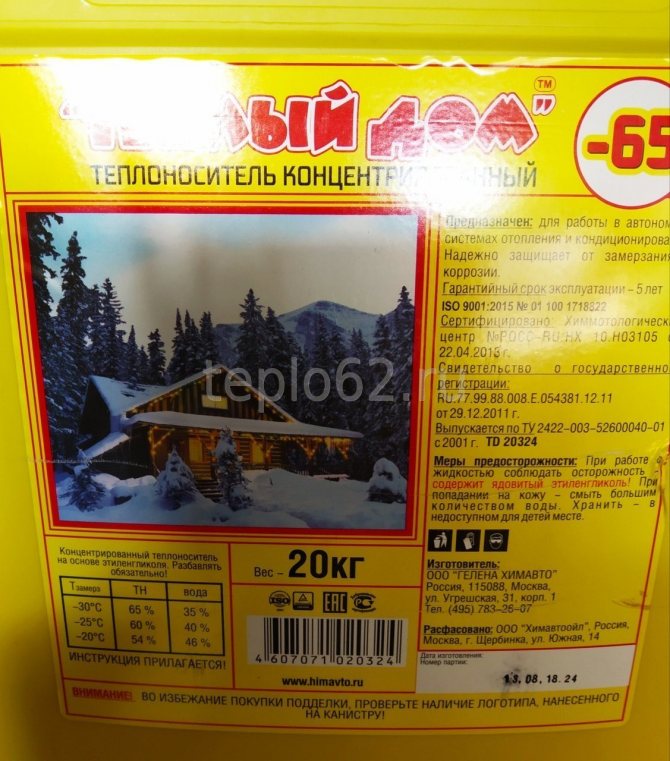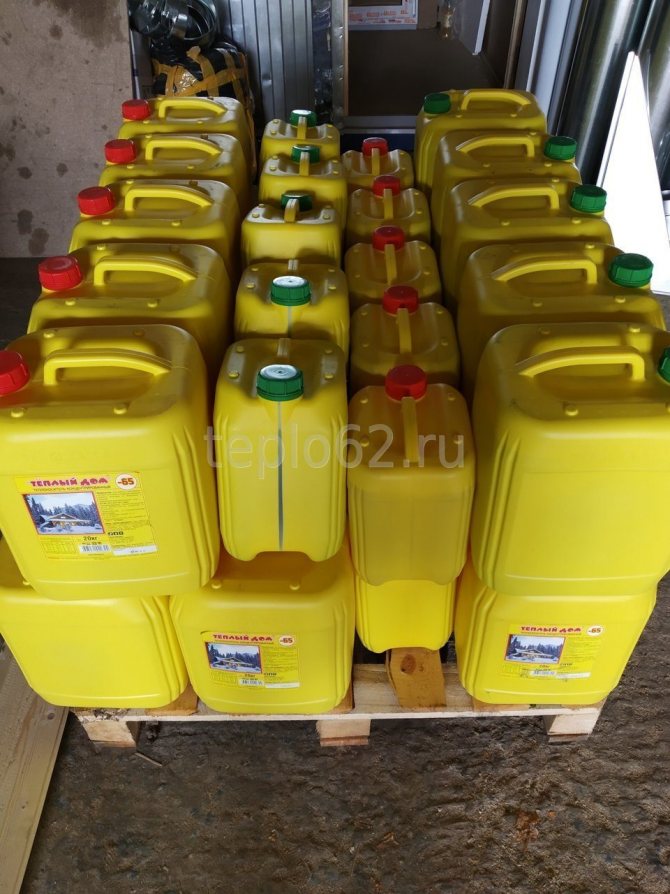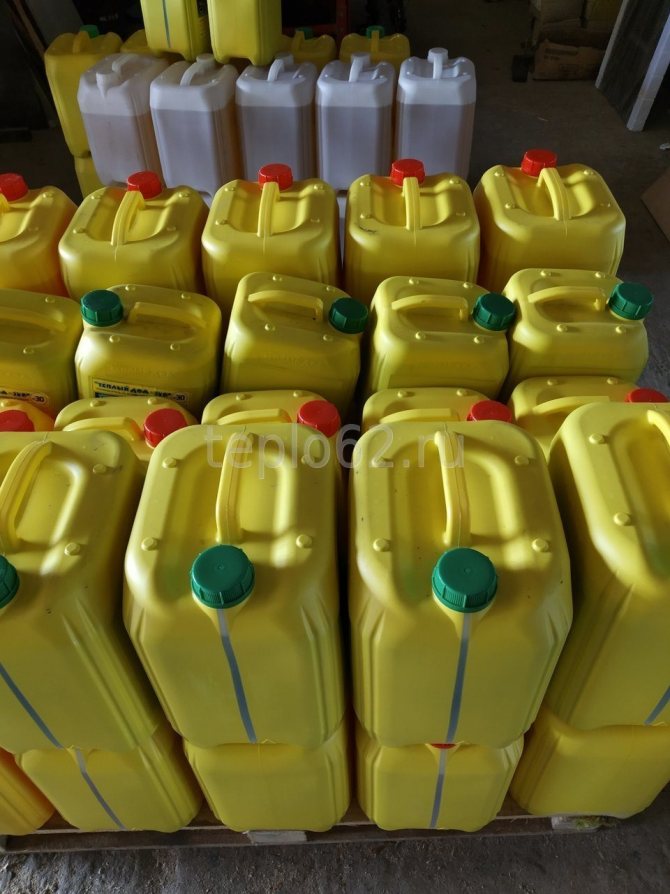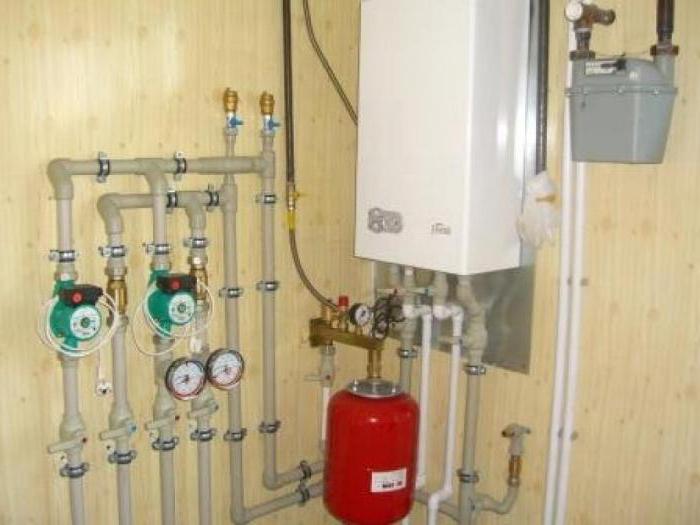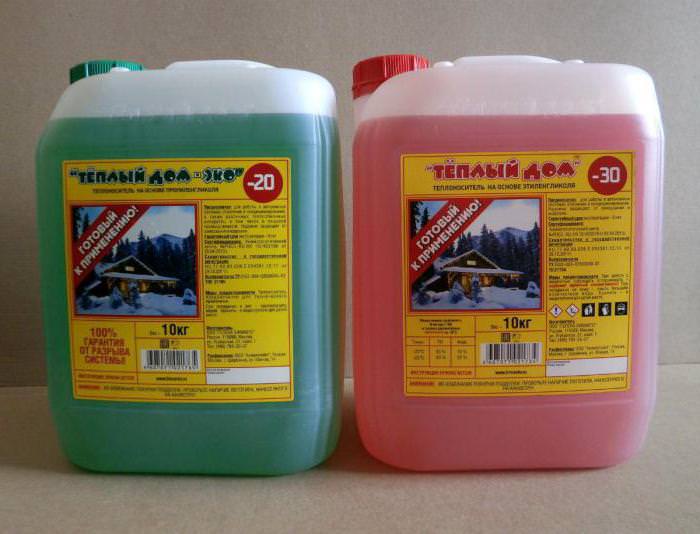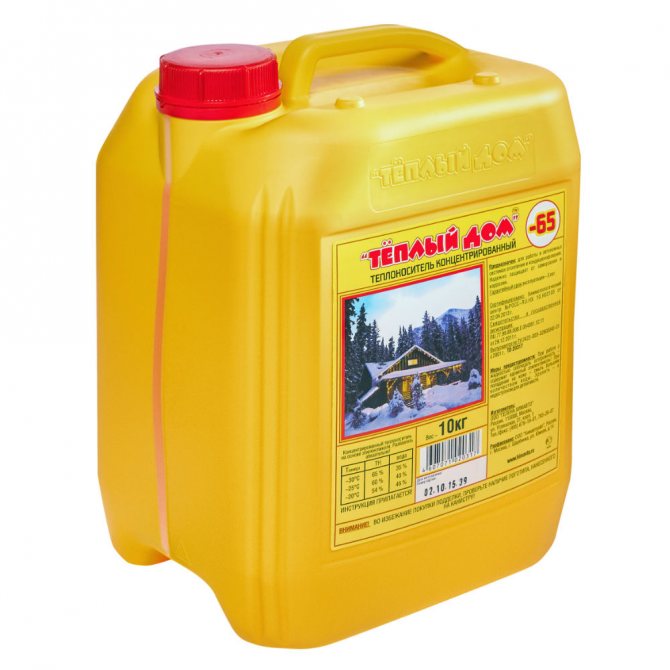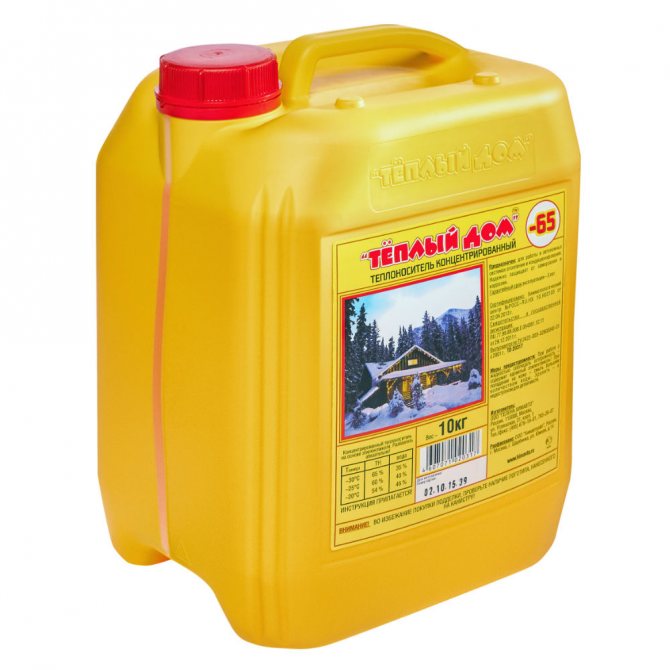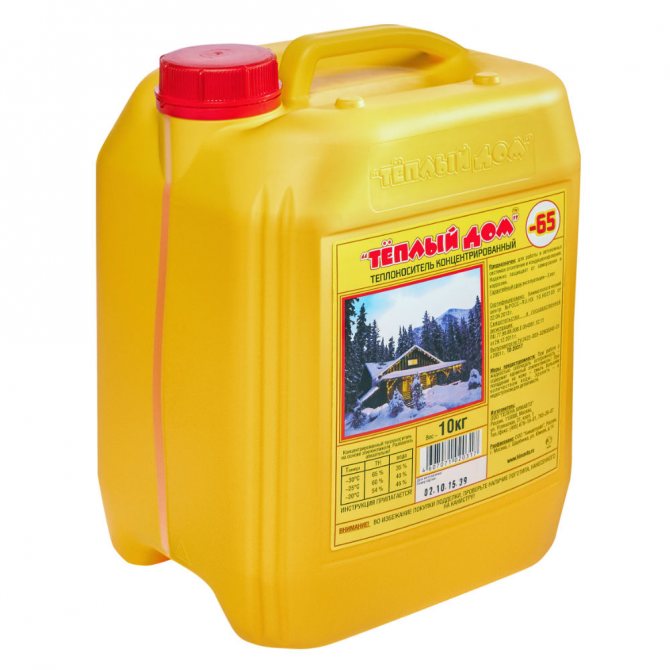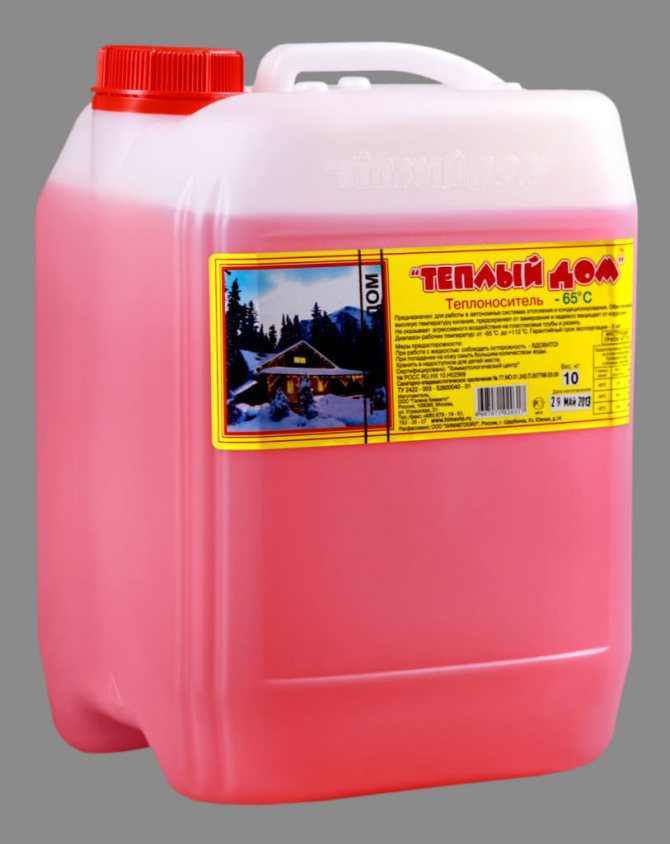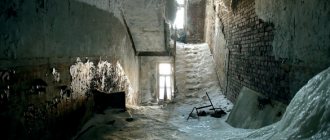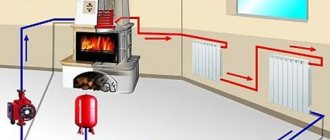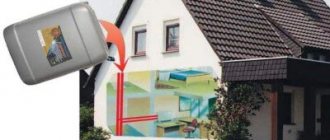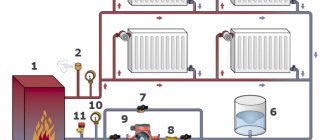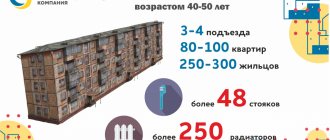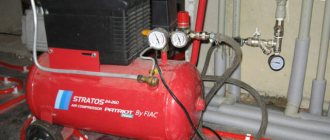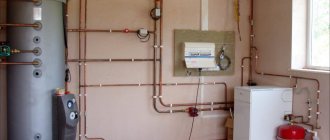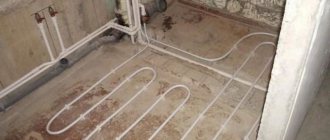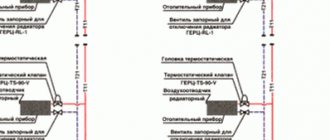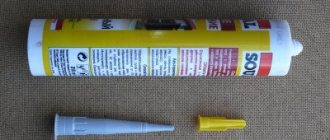"Warm House" is a liquid that is a modern anti-freeze composition made from high quality ethylene glycol. This mixture is intended for use in various heating or cooling systems, as well as for industrial air conditioning.
This antifreeze can be used at temperatures ranging from -65 to + 112 ° C. The additive package consists of 10 substances that give the coolant antifoam, anti-corrosion and stabilizing properties in the operating temperature range.
Description
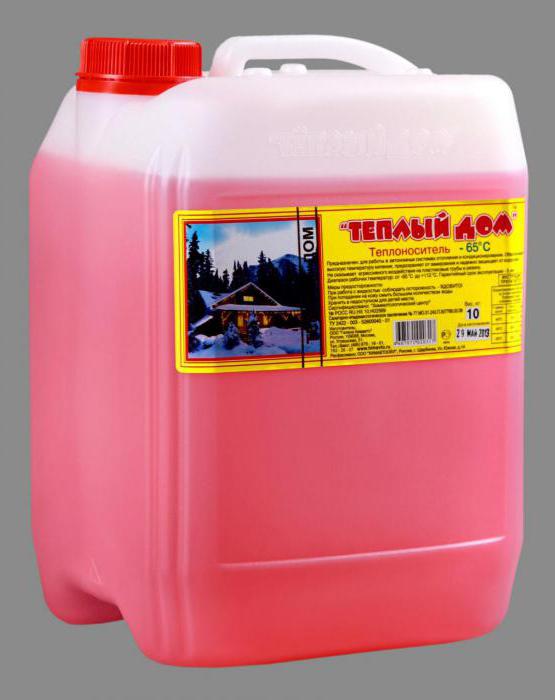
"Warm House" - a liquid that is a concentrated antifreeze produced using a combined package of anti-scale and other additives. All these ingredients are used to obtain heating fluids that have a low crystallization temperature, that is, freezing.
Reducing the amount of ethylene glycol increases the thermal conductivity and heat capacity, which lowers the freezing point. The viscosity of the solution is reduced, and this made it possible to improve the circulation of the coolant in the system, increasing the heat transfer.
"Warm House" is a liquid that best suits its thermophysical properties for the climatic zone of central Russia. The best are those antifreezes that begin to crystallize at a temperature of -25 ° C. If we are talking about the described solution, then it freezes at lower temperatures.
Why choose Teply Dom brand antifreeze
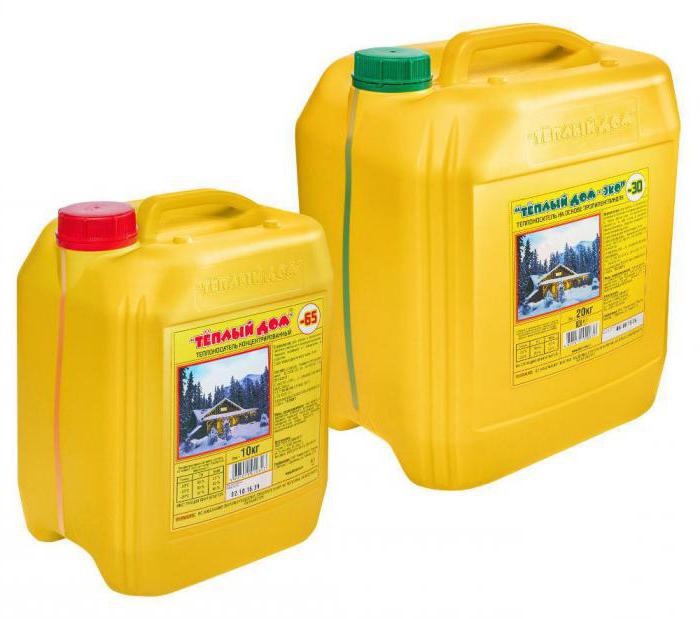

Non-freezing liquid for heating "Warm House" can protect the heating from destruction, which is ensured by the thermophysical characteristics of the composition, even if the system is faced with an emergency stop problem. The pipes will not collapse, because the composition at lower temperatures turns into a jelly-like state.
If you use heat transfer fluids with a high content of ethylene glycol, then this can cause carbon deposits on the surface of the heating elements or in the area of the burner. Among other things, you may encounter the problem of the formation of tarry deposits, as well as overheating of heating elements.
In order to obtain an aqueous solution with the required operating temperature, it is necessary to dilute the liquid for "Warm House" batteries with distilled water or water taken from the water supply system.
Heat carrier "Teply Dom 65" - concentrated antifreeze liquid for refrigeration
Concentrated heating medium "Warm House-65" (TD-65)
is made from high quality ethylene glycol and is intended for use as an antifreeze liquid (antifreeze) in various heating (cooling) and industrial air conditioning systems in the range of operating temperatures from -65 ° C to 112 ° C.
A special package of additives, consisting of 10 (ten) substances-components, used in the coolant Warm House 65, is designed to give the coolant anti-corrosion, antifoam and antifoam properties, as well as to stabilize the thermophysical properties over the entire operating temperature range.
The quality characteristics of Teply Dom heat carriers for air conditioning (cooling and heating) systems must meet the requirements GOST 28084-89 "Non-freezing cooling liquids"
and technical specifications developed on its basis.
Concentrated heat carrier Teply Dom 65
produced with the use of a combined package of anti-corrosion, anti-scale and antifoam additives and is designed to obtain heating fluids
- aqueous solutions with a lower crystallization (freezing) temperature. A decrease in the concentration of ethylene glycol (which also lowers the freezing point - the beginning of crystallization) makes it possible to increase the heat capacity and thermal conductivity of the solution, as well as significantly reduce the viscosity, thereby improving the circulation of the coolant in the system and significantly increasing the heat transfer of the system. The best thermophysical characteristics for the climatic zone of Central Russia are possessed by coolants manufactured at temperatures of the onset of crystallization at -25 ° C
and on
-30 ° C
.
Concentrated heat carrier "Warm House 65" (TD-65) on ethylene glycol - antifreeze liquid for air conditioning and heating systems
(65% concentration, with anti-corrosion, anti-scale, anti-foam and stabilizing additives)
| Packing, weight in kg | The temperature of the beginning of crystallization (freezing), t ° C | Sale / Price in rubles / kg with VAT, when ordering up to 1 ton | Sale / Price in rubles / kg with VAT, when ordering more than 1 ton |
| Canister 20 kg, Can 50 kg | minus -65 ° C | 80,00 RUB / kg | depending on the batch size |
Concentrated heat carrier "Warm House 65" (TD-65) on ethylene glycol - antifreeze liquid for air conditioning and heating systems
(65% concentration, with anti-corrosion, anti-scale, anti-foam and stabilizing additives)
| Packing, weight in kg | The temperature of the beginning of crystallization (freezing), t ° C | Sale / Price in rubles / kg with VAT, when ordering from 1 ton | Sale / Price in rubles / kg with VAT, when ordering more than 2 tons |
| Barrel, 230 kg | minus -65 ° C | 77,00 RUB / kg | depending on the batch size |
Heating fluids with such thermophysical characteristics are guaranteed to protect the system from destruction in the event of an emergency stop even at lower temperatures in the working rooms and in the system itself, since ethylene glycol solutions crystallize into a jelly-like form. The use of heat carriers with a high concentration of ethylene glycol is more likely to lead to their soot on the heating elements or in the burner zone and the formation of tarry deposits, burnout of electric heating elements (TENs).
To obtain an aqueous solution with the required operating temperature (temperature of the onset of crystallization, freezing), the coolant "Warm House-65" (TD-65) should be diluted with distilled water or tap water with a total hardness not exceeding 6 mEq / l in accordance with the table below:
Recipe-calculation for obtaining 100 liters of ready-made solution from the concentrated heat carrier "Warm House 65":
| Heat carrier "Warm House 65", l | Water, l | Freezing (crystallization) onset temperature, t ° C |
| 77 Liters | 23 liters | -40 ° C |
| 65 liters | 35 liters | -30 ° C |
| 60 liters | 40 liters | -25 ° C |
| 54 liters | 46 liters | -20 ° C |
For any other amount of aqueous solution (according to the selected crystallization temperature and the corresponding values in the line !!!)
, the values of the heat carrier and water given in the table, in liters, proportionally increase or decrease by the value of the coefficient
K = V / 100
, where V is the volume of the prepared coolant solution, for example, if the volume
V
= 56 liters, then the coefficient
K
= 0.56; if volume
V
= 1559 liters, then the coefficient
K
=15,59.
And it should also be borne in mind that the "Warm House 65" coolant is poured into canisters (barrels) in kilograms (by weight) and this must be taken into account when calculating: at a temperature of 20 ° C 1l = 1.087kg, 1kg = 0.92l. Therefore, in order not to complicate the calculations by the influence of temperature on the density of the coolant, we recommend making the necessary solution at an ambient temperature close to 20 ° C and performing all operations in volume fractions, in liters.
If water from wells, wells, etc. is used to dilute the coolant, where an increased content of salts and metals is possible, then it is recommended that a small volume of the coolant Teply Dom 65 be mixed with water in the required proportion in a transparent container and make sure that there is no sediment.The mixing of the coolant with water can be carried out immediately before filling the system (especially for systems with natural circulation) or by filling it alternately in small portions.
Heat carriers Teply Dom 65 due to complex additives have high stability of thermophysical properties and provide continuous operation for 5 years. After five years of operation, the coolant will remain a low-freezing liquid, but the resource of additives to counteract corrosion and scale will be exhausted. Therefore, the coolant must be drained and disposed of. Before pouring a new coolant, the system must be flushed with a special liquid or water.
It should be borne in mind that the service life of the coolant depends on the conditions of its operation. We do not recommend:
- pour coolants into systems with galvanized pipes, since galvanized peeling and precipitation are possible;
- use heat carriers in heating systems with electrolysis boilers of the "Galan" type;
- mix the heat carriers of the Warm House with other heat carriers, as this will definitely lead to a deterioration in the operational properties of the heat carrier, and as a result, damage to the equipment is possible;
- to bring the coolants to a boiling state during operation, as this leads to the decomposition of additives and ethylene glycol and deterioration of the thermophysical properties of the coolant with a decrease in the service life of the solution.
Heat carrier "Warm House 65"
for technical use only (ethylene glycol is toxic). To avoid poisoning, do not allow it to enter food and drinking water. In contact with clothing or exposed parts of the body, it is easily washed off with soap and water.
Heat carriers Teply Dom are fire- and explosion-proof, have certificates of conformity and sanitary and epidemiological conclusions, have been tested at the Scientific Research Institute of Plumbing and are approved for widespread use.
The heat transfer fluids should be stored out of the reach of children, in a sealed container, away from food, keep out of direct sunlight.
We are interested in mutually beneficial cooperation.
Recipe for the preparation of a 100 l solution from a concentrated heat carrier
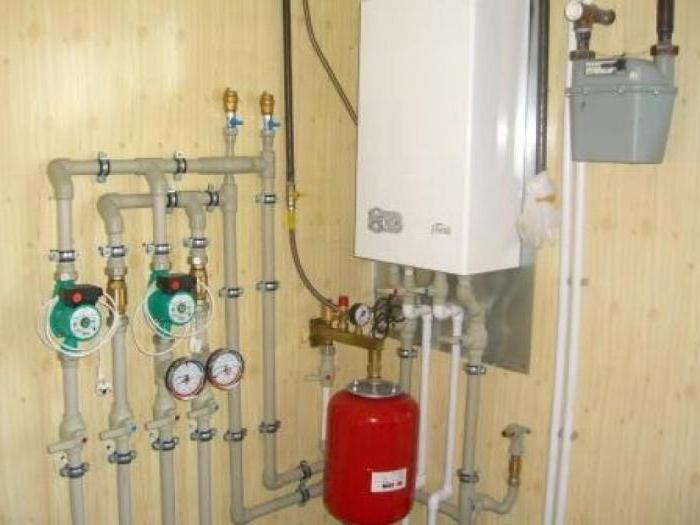

"Warm House" is a liquid that can be used to prepare a ready-made solution that is poured into the heating system. The proportions of the ingredients will affect the temperature at which they begin to freeze or crystallize. Thus, if 77 liters of coolant are added to 23 liters of water, the temperature of the onset of freezing will be kept at around -40 ° С.
By adding 65 liters of coolant to 35 liters of water, you will achieve that you create a solution that will freeze at a temperature of -30 ° C.
Forty liters of water and 60 liters of coolant will produce a solution that will begin to crystallize at 25 ° C below zero. If the thermometer in your house does not drop below -20 ° C, then 54 liters of coolant will be enough for 46 liters of water.
Characteristics
The main components of the Warm House mixtures are such substances as propylene glycol and ethylene glycol. It also contains special anti-plaque additives and other additives. This material is used for heating systems in private houses, as well as in industrial enterprises. Another purpose of such formulations is for use in air conditioning systems.
Antifreeze protects the heating system from freezing during operation at temperatures below zero degrees. The composition "Warm House" is designed for use at temperatures ranging from -40 to +106 degrees. However, it should be remembered that there are several modifications of fluids of this brand with different technical characteristics.
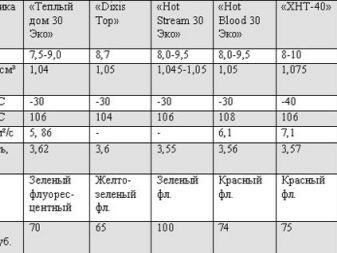

Also, the agent protects heating boilers, radiators and pipes from the formation of scale, rust, mill scale.
This composition does not adversely affect plastic, rubber and other non-metallic materials. Therefore, you do not need to worry about the safety of non-metallic elements of the heating system. The liquid will not damage materials or cause pipe leaks.
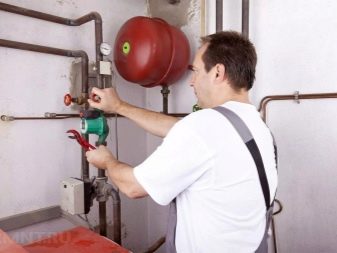

Recommendations for use
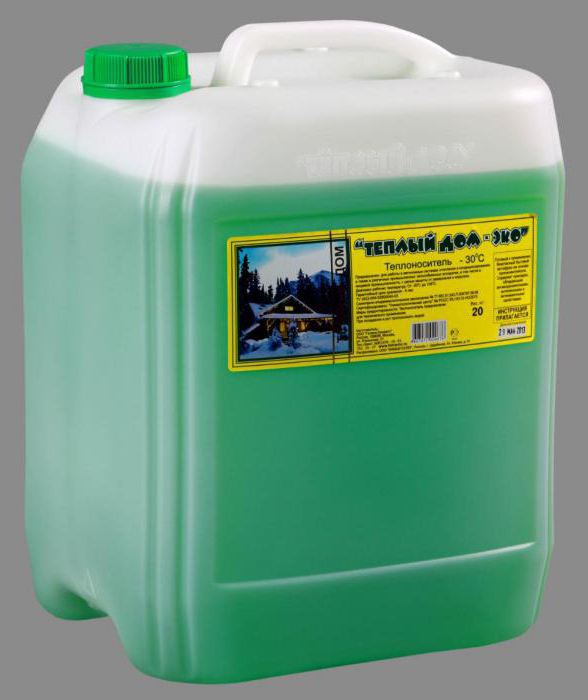

Liquid "Warm House" can be diluted with water from a well or well, but it should be borne in mind that in this case, you may encounter an increased content of metals and salts. In order to avoid problems during the operation of the heating system, a small volume of the coolant should be previously mixed with water. Use a transparent container for this. As a result, you should get a clear solution so that you can make sure that there is no sediment. This mixing can be done before filling the system, especially for natural circulation systems.
The described coolant is characterized by high stability of thermophysical properties, therefore, it will be able to ensure continuous operation of the system for 5 years. After this period, the coolant will be a low-freezing liquid, but it can already be considered a solution that has exhausted the resource of additives, because of which you may encounter an increase in scale and corrosion. Therefore, the coolant is drained and disposed of. Before pouring a new batch, the system is flushed with water or a special liquid.
Varieties of "Warm House" liquid
Today, there are several types of antifreeze in question on sale. Below are their characteristics and descriptions.
ECO-20
EKO-20 is manufactured from a professional inhibitor with pronounced anti-corrosion properties, it contains additives that ensure the absence of foaming, scale formation in the heating and water supply system. It is neutral in relation to seals, various types of plastic and rubber.
The constancy of the chemical properties of the coolant ensures trouble-free operation for five years.
"Warm House" -30
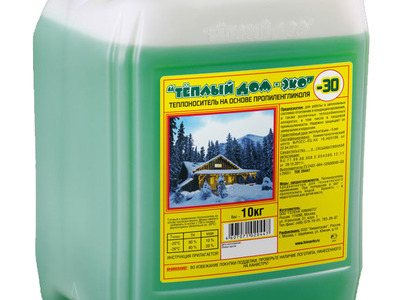

Liquid is discharged based on high quality propylene glycol, has only green color.
It is widely used in heating and water supply systems, has passed the necessary tests and has certificates confirming its quality.
Issued in cans of 10 l, special additives (inhibitors) increase the life of antifreeze, reduce the degree of foaming during operation, and prevent corrosion.
The operating temperature range is from -45 ° C to 106 ° C.
Important! Correct operation of the heating system allows extend the period high-quality solution work for 10 seasons.
"Warm House" -65
The liquid consists from ethylene glycol and proved to be excellent when working in the temperature range -65 ° C +112 ° C... When the temperature drops, the antifreeze does not freeze. And with an increase in volume, its consistency changes to a gel-like structure. When diluted with water, the viscosity of the final product decreases, and the thermal conductivity index increases.
Dependence of the service life of the coolant on operating conditions
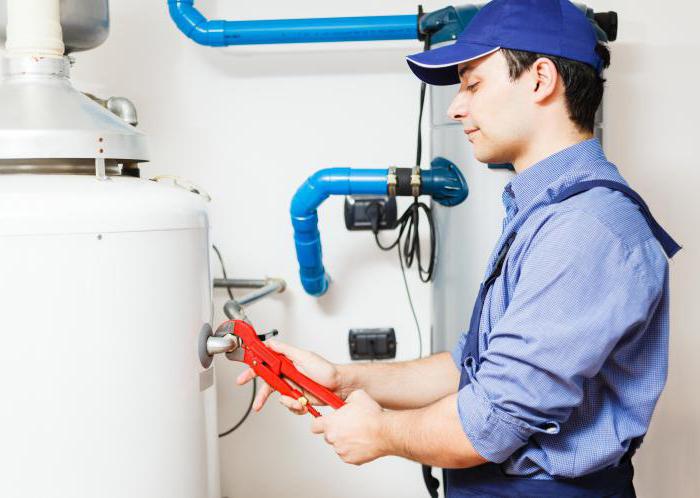

Liquid "Warm House" will last longer if you provide it with appropriate operating conditions. So, experts do not recommend pouring liquid into a system that is equipped with galvanized pipes. This leads to the possibility of galvanizing delamination, in addition, sediment may form. In addition, the described heat carrier cannot be used in heating, where there is an electrolysis boiler of the "Galan" type.
The heating fluid should not be mixed with other antifreezes, as this will result in poor performance and possible damage to equipment.The coolant should not be brought to a boiling state during operation, since ethylene glycol and additives will decompose in this case, and their thermophysical properties will certainly deteriorate, which is why the coolant will last less than the prescribed period.
"Warm House" is a heating fluid that can be used exclusively for technical purposes, because ethylene glycol is toxic. In order to exclude poisoning, care must be taken to prevent antifreeze from getting into drinking water and food. If it is on clothes or exposed areas of the body, wash them with soap and water. The coolant is explosion and fire safe, it has certificates of conformity and a conclusion on sanitary and epidemiological standards.
The main characteristic of antifreeze
In a number of non-freezing liquids "Warm House" there are products based on ethylene glycol and propylene glycol. Both types of coolants are created according to the rules of environmental safety. Antifreeze does not freeze even at a critical temperature mark, so you can safely leave your house unattended on weekends. The solution does not harm rubber, metal-plastic, plastic and flax.
Read the same: varieties of antifreeze for heating systems in private houses.
Model line
For the convenience of consumers, the manufacturer has introduced several types of antifreeze.
In this video, we will consider the types of "Warm House" antifreeze: The model line includes the following products:
- ECO-20. Non-freezing green liquid. The solution is based on propylene glycol. It can be used for two types of heating equipment, but primarily it is produced for double-circuit boilers.
- Series 30. Composition of red color, produced on the basis of ethylene glycol. Ideal for single-circuit systems, but can also be used for dual-circuit equipment. The solution should be diluted with water according to the instructions. This antifreeze must not be used in its pure form.
- ECO-30. Green solution with propylene glycol. Before use, dilute the composition with water to -20 ° C.
- Series 60. Red liquid with a high content of ethylene glycol. The manufacturer recommends mixing antifreeze with water down to -20… -30 ° C.
Advantages and disadvantages
All varieties of "Warm House" antifreezes have their pros and cons.
The following advantages of this product can be highlighted:
- Wide range of temperature modes from -30 to + 106 ° C.
- Long service life (from 5 to 8 years).
- Safety for the heating system, prevention of leaks with good tightness.
- Environmental friendliness, absence of toxic fumes during weathering.
- Absolute fire safety.
Any tool has its drawbacks. Antifreezes "Warm House" are no exception. Users highlight the following disadvantages:
- Non-freezing liquids are only suitable for gas heating. Do not use solutions in heating equipment with an electric boiler.
- Some types of antifreeze contain a high concentration of salt. This can contribute to the formation of limescale.
- To achieve the desired effect, it is required to mix the solution and water exactly according to the instructions. Failure to follow the recommendations can lead to carbon deposits.
The liquid must not be mixed with other antifreezes. When diluted, the additive package loses its properties. Moreover, dilution neutralizes the anti-corrosion effect.
Additional properties of the heat carrier for the heating system
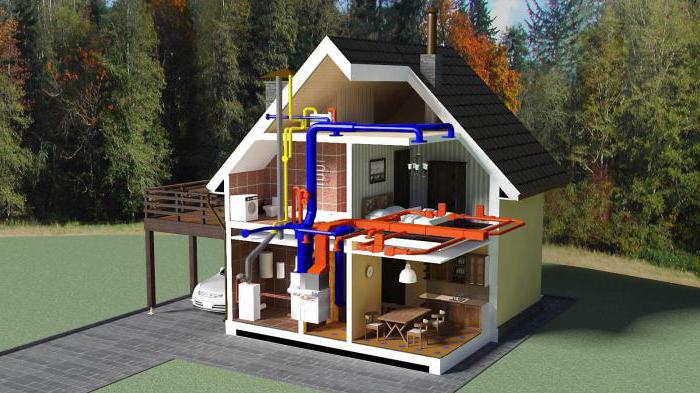

In order to ensure the necessary circulation of antifreeze in the system, it is necessary to supplement it with a more powerful circulation pump compared to what is used when working with water. The capacity and power should be increased by 15% and the head by 50%.
At negative temperatures in the system, heating of the coolant should be carried out gradually, while the power should be increased in stages. The equipment should be calculated and designed taking into account such thermophysical characteristics that differ from those suitable for water. This applies to air conditioning systems, etc.
"Warm house" is a heating fluid that has a higher coefficient of volumetric expansion when compared with water. Therefore, you should stock up on an expansion tank of a more impressive volume. Before you start pouring a new coolant into the system, it is imperative to check all connections and assemblies, which is especially true for the case when propylene glycol antifreezes were used.
Safe operating conditions
Autonomous supply system
For the correct use of the coolant, it is necessary to ensure the appropriate operating parameters of the heating system. The liquid temperature should not exceed 170 ° С - to avoid boiling. Therefore, the solution is diluted with plain water and a high circulation rate is provided. If you decide to replace the water in the pipes with a special composition, then you need to increase the pressure by 60% and the productivity by 10%. It is also necessary to expand the tank of the system - by about 15%.
When starting up for the first time, the boiler should warm up gradually, starting from the minimum output. Then it is gradually increased until it reaches the operating mode.
- everything about building a house and repairing an apartment yourself.
For reference
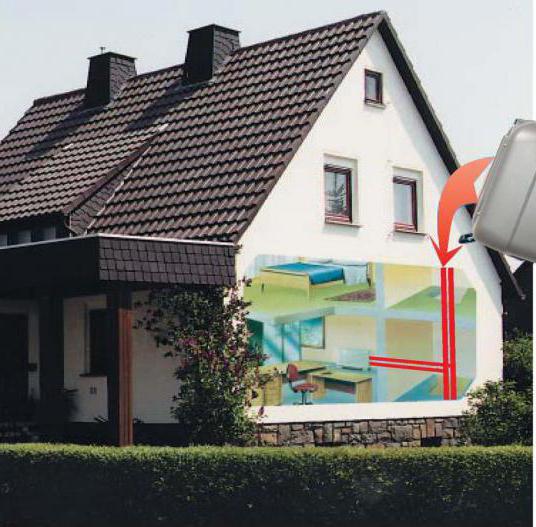

Non-freezing liquid "Warm House" is sold in a container. If necessary, you can buy antifreeze in plastic packaging, the volume of which is limited to 10, 20 and 50 liters. A barrel with a volume of 216 liters can be purchased on request.
Sometimes the mixture is shipped in bulk, in this case, as a rule, fuel trucks and cubes are used. If an order is made from 2 tons, then the coolant can be manufactured as a water-glycol mixture with a crystallization temperature at any level that is chosen by the consumer.
Varieties
The main classification of liquids "Warm House" is based on the differences in the main component of the composition. Green polypropylene glycol-based mixtures are available in several modifications.
- "Warm house ECO - 30". This modification has some distinctive features in use. If the mixture is used for double-circuit or heating elements electric boilers, then it must be mixed with water (temperature -20 degrees).
- "Warm house ECO - 20". This composition is suitable for both single-level and two-level gas boilers. It is mainly used for double-circuit equipment.

